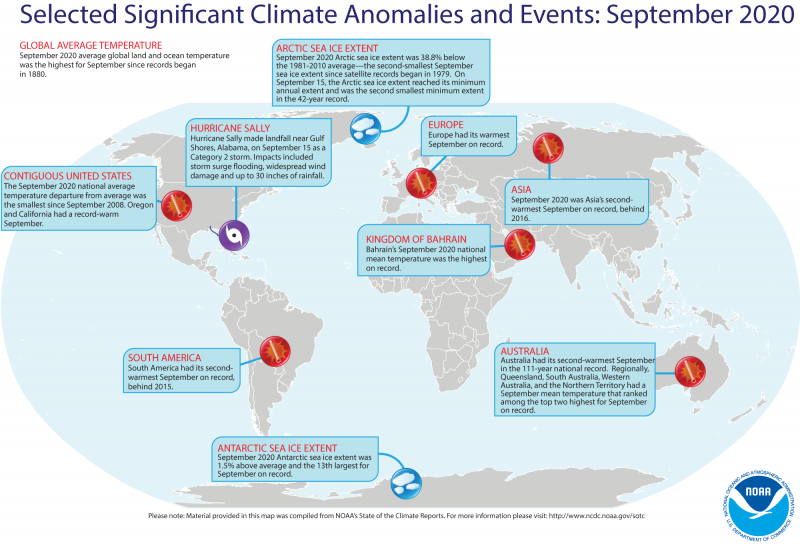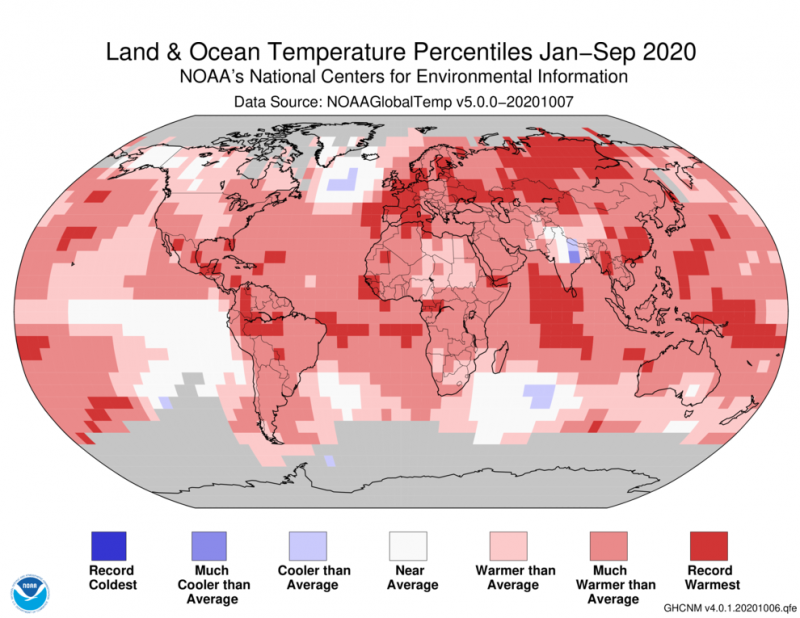

View larger. | A map of the world plotted with some of the most significant weather and climate events that occurred during September 2020. Image via NOAA.
According to scientists at NOAA’s National Centers for Environmental Information (NCEI), unprecedented heat around the world vaulted September 2020 to the hottest September since 1880.
The NOAA report, released October 14, says that September’s warmth also contributed to 2020’s trend as a remarkably hot year, with the year-to-date global temperatures running second highest in the 141-year climate record. According to a statistical analysis done by NCEI scientists, 2020 will very likely rank among the top three warmest years on record.
September 2020’s average global temperature was 1.75 degrees F (0.97 of a degree C ) above the 20th-century average of 59 degrees F (15 degrees C). This surpasses the average global temperatures for both September 2015 and 2016 by 0.04 of a degree F (0.02 of a degree C), which previously tied for the hottest Septembers on record.
The 10-warmest Septembers have all occurred since 2005, with the seven-warmest Septembers occurring in the last seven years.

View larger. | The year-to-date global land and ocean surface temperature was the second highest in the 141-year record at 1.84°F (1.02°C) above the 20th-century average of 57.5°F (14.1°C). This value is only 0.07°F (0.04°C) shy of tying the record set in 2016. Image via NOAA
The year-to-date (January-September 2020) average global temperature was the second hottest on record at 1.84 degrees F (1.02 degrees C) above the 20th-century average. This is only 0.07 of a degree F (0.04 of a degree C) shy of the record set for the same YTD in 2016.
In addtion, Arctic sea ice was at near-record lows. An analysis of satellite data by NASA and the National Snow and Ice Data Center showed that Arctic sea ice that the 2020’s minimum extent of Arctic sea ice – the smallest area of the floating sea ice cover of the year – likely reached September 15, was the second-lowest extent (behind 2012) since modern record keeping began in the late 1970. The 14 smallest minimum annual extents have occurred in the last 14 years.
Mark Serreze, director of the National Snow and Ice Data Center, told CNN:
This is telling us that the Arctic Ocean is on a trajectory to have a seasonally ice-free Arctic Ocean, and this year is another nail in the coffin. The 14 lowest sea ice extents have occurred in the past 14 years. It never got any better, and there is no indication of recovery. We are in a new Arctic, something we have never seen before.
It’s been a record-hot year-to-date so far for some parts of the globe: Europe, Asia and the Gulf of Mexico had their warmest January-through-September period on record; South America and the Caribbean region had their second highest. No land or ocean areas had record-cold year-to-date temperatures.
Read the complete September climate report from NOAA/ NCEI.
Bottom line: September 2020 was the hottest global September in the 181-year record.
from EarthSky https://ift.tt/2FK6cv3


View larger. | A map of the world plotted with some of the most significant weather and climate events that occurred during September 2020. Image via NOAA.
According to scientists at NOAA’s National Centers for Environmental Information (NCEI), unprecedented heat around the world vaulted September 2020 to the hottest September since 1880.
The NOAA report, released October 14, says that September’s warmth also contributed to 2020’s trend as a remarkably hot year, with the year-to-date global temperatures running second highest in the 141-year climate record. According to a statistical analysis done by NCEI scientists, 2020 will very likely rank among the top three warmest years on record.
September 2020’s average global temperature was 1.75 degrees F (0.97 of a degree C ) above the 20th-century average of 59 degrees F (15 degrees C). This surpasses the average global temperatures for both September 2015 and 2016 by 0.04 of a degree F (0.02 of a degree C), which previously tied for the hottest Septembers on record.
The 10-warmest Septembers have all occurred since 2005, with the seven-warmest Septembers occurring in the last seven years.

View larger. | The year-to-date global land and ocean surface temperature was the second highest in the 141-year record at 1.84°F (1.02°C) above the 20th-century average of 57.5°F (14.1°C). This value is only 0.07°F (0.04°C) shy of tying the record set in 2016. Image via NOAA
The year-to-date (January-September 2020) average global temperature was the second hottest on record at 1.84 degrees F (1.02 degrees C) above the 20th-century average. This is only 0.07 of a degree F (0.04 of a degree C) shy of the record set for the same YTD in 2016.
In addtion, Arctic sea ice was at near-record lows. An analysis of satellite data by NASA and the National Snow and Ice Data Center showed that Arctic sea ice that the 2020’s minimum extent of Arctic sea ice – the smallest area of the floating sea ice cover of the year – likely reached September 15, was the second-lowest extent (behind 2012) since modern record keeping began in the late 1970. The 14 smallest minimum annual extents have occurred in the last 14 years.
Mark Serreze, director of the National Snow and Ice Data Center, told CNN:
This is telling us that the Arctic Ocean is on a trajectory to have a seasonally ice-free Arctic Ocean, and this year is another nail in the coffin. The 14 lowest sea ice extents have occurred in the past 14 years. It never got any better, and there is no indication of recovery. We are in a new Arctic, something we have never seen before.
It’s been a record-hot year-to-date so far for some parts of the globe: Europe, Asia and the Gulf of Mexico had their warmest January-through-September period on record; South America and the Caribbean region had their second highest. No land or ocean areas had record-cold year-to-date temperatures.
Read the complete September climate report from NOAA/ NCEI.
Bottom line: September 2020 was the hottest global September in the 181-year record.
from EarthSky https://ift.tt/2FK6cv3

Aucun commentaire:
Enregistrer un commentaire